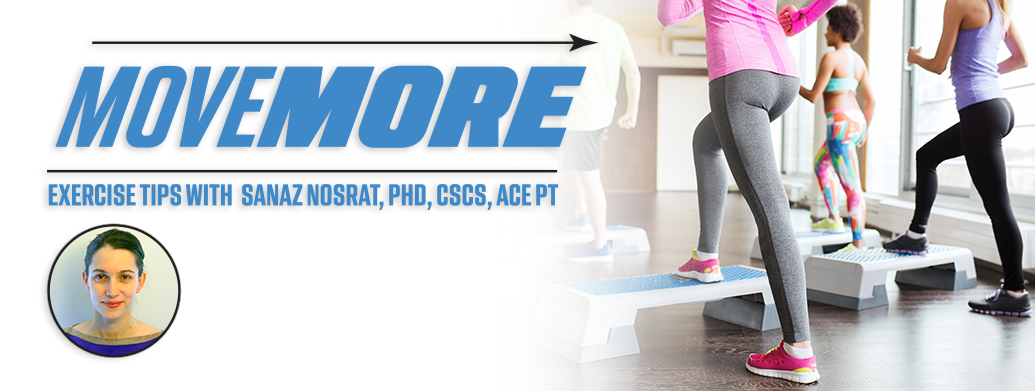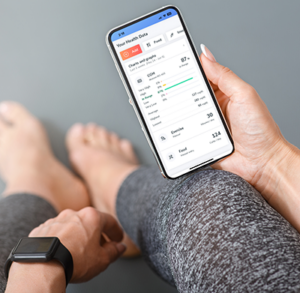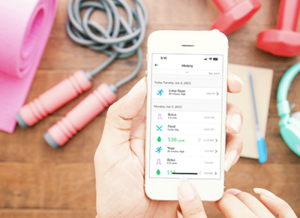
 Welcome back to Glooko’s blog on exercise and physical activity.
Welcome back to Glooko’s blog on exercise and physical activity.
I hope by now you’ve read my previous blog post on how to increase your daily physical activity. In that post, I shared why daily activities are important for our health and suggested some tips on how to incorporate them into your routine. This time around, I’m going to discuss the benefits of adding structured aerobic exercise into your life and give you some tips on how to design and stick to your program.
Before you start any exercise program, it’s always important to ask your healthcare provider to make sure you are medically cleared to exercise.
WHAT IS AEROBIC EXERCISE?
“Aerobic exercise,” also referred to as “cardio” or “cardiorespiratory exercise” is any rhythmic, repeated movement that is performed for at least 5 minutes. Some examples include brisk walking, jogging, running, swimming, bicycling, the use of an elliptical machine, water aerobics and a step class.
Aerobic exercise has numerous benefits for you whether you’re a person living with diabetes or any other related chronic conditions, or living without any chronic condition. According to the CDC and WHO, these benefits include having better glycemic control, easier weight management, prevention of heart disease and high blood pressure, a better blood lipid profile (think of your cholesterol, LDL and HDL), and better sleep and mood.
DESIGN YOUR AEROBIC EXERCISE PROGRAM
So, how should you start? Here are four important variables that you can modify to design your aerobic exercise program.
- Mode: This is the type of exercise you can do. I know “walking” is a popular form of aerobic exercise, but not everyone needs to start with that. You might like the elliptical machine in the gym better than walking. Or you might prefer a dance class at your local gym, while another person might prefer water aerobics. Pick an exercise and see if you like it. You can mix them up as well and have a variety of activities that you can pick from when you want to work out.
- Duration: Now it’s time to decide how many minutes you want to do the activity. You can start with 10 minutes and increase that over time. Aim to finally achieve 30 minutes of this activity in each session. How do you gradually increase the duration of your activity? Here is an example: after completing three sessions of aerobic activity, you can increase the duration of the fourth session by 3 to 5 minutes. Keep on doing this until you reach your 30-minute goal.
- Frequency: This is the number of times you need to repeat this activity during the week. You can start with once per week and increase that gradually to 3 to 5 times per week.
 Intensity: It’s also important to decide at what intensity you want to work out. Aerobic exercise can be performed in low, moderate or high (vigorous) intensities. One way to determine the intensity of your exercise is to purchase a heart rate monitor or a fitness tracker, many of which are compatible with the Glooko® Mobile App. The other way you can determine the intensity of your workouts is with a talk test. When you are at a low to moderate intensity, you will be able to carry a conversation, but won’t be able to sing. When at a high (vigorous) intensity, you can’t say more than a few words without pausing to catch a breath. So what intensity should you start with? It’s always better to start with low to moderate intensity. You will enjoy your moderate intensity workouts more and chances are you will stick to them as well!
Intensity: It’s also important to decide at what intensity you want to work out. Aerobic exercise can be performed in low, moderate or high (vigorous) intensities. One way to determine the intensity of your exercise is to purchase a heart rate monitor or a fitness tracker, many of which are compatible with the Glooko® Mobile App. The other way you can determine the intensity of your workouts is with a talk test. When you are at a low to moderate intensity, you will be able to carry a conversation, but won’t be able to sing. When at a high (vigorous) intensity, you can’t say more than a few words without pausing to catch a breath. So what intensity should you start with? It’s always better to start with low to moderate intensity. You will enjoy your moderate intensity workouts more and chances are you will stick to them as well!
You now have four main variables of mode, duration, frequency and intensity to modify and design your workouts. It’s important to emphasize that it’s always better to increase the duration and frequency of your activity first, and if you like, you can then increase the intensity. Always remember to increase these variables gradually. This way, you are more likely to adhere to your exercise program and the risk of musculoskeletal injuries will be lower.
HOW DO I STICK TO MY NEW AEROBIC EXERCISE PROGRAM?
It’s time now for some tips to help you adhere to your new aerobic exercise program.
- Make it fun. Choose an activity that’s fun for you. Exercising should not be boring, uncomfortable, or painful. It’s possible to enjoy an exercise program and still reap the benefits.
- “No pain, No gain” is a myth. Exercise doesn’t have to be painful to be beneficial. Most people don’t enjoy higher exercise intensities and feel too uncomfortable while doing it. If you are one of those people, remember that you can stick to moderate intensity and still get all the benefits. Research from Sports Medicine shows that low to moderate intensity aerobic exercise is more enjoyable than high intensity aerobic exercise, especially if you are new to the exercise program.
- Start slow. I know it might be exciting to go all out at the beginning, or to test your abilities to see how intense or how long you can work out, but It’s safer and more enjoyable if you start slow and let your body adapt and get used to the exercise program gradually.
- Spread out your workouts. You can complete a 30-minute workout in one session or spread it out during the day. For example, you can go for a brisk walk three times per day each time for 10 minutes rather than completing a 30-minute walk at once.
- Consider doing low-impact activities. If you have any issues with your feet, such as peripheral neuropathy, or if you experience pain in your joints from time to time, it would be safer and more beneficial if you choose non-weight bearing aerobic exercises like swimming or bicycling. Always wear comfortable shoes and inspect your feet after each workout for any potential irritated spots.
- This is a long-term goal. Although you might experience positive changes in mood and energy levels immediately after each session (which is great!), you need to stick to your program for a couple of months at least and make it an essential part of your new healthier routine to experience most of the benefits of aerobic exercise.
- Be kind to yourself. It’s possible that you may miss some of your planned exercise sessions, become frustrated and even decide you want to stop exercising altogether. Just remember that this is a lifestyle change and everything can’t be perfect all the time. Be kind to yourself and get back to your plan every time you relapse. It will eventually become easier to stick to your exercise plans.
 Monitor your blood glucose. Be sure to monitor your blood glucose before, during (if possible), and after an exercise session to learn how your body reacts to your new exercise routine. Take a look at this helpful information from the American Diabetes Association and see how you can get started safely with exercise while monitoring your blood glucose. Don’t forget to use the newly redesigned Glooko app to sync your blood glucose data and track your aerobic exercise routine. This way, you can always look back at your health data and find out what works best for you.
Monitor your blood glucose. Be sure to monitor your blood glucose before, during (if possible), and after an exercise session to learn how your body reacts to your new exercise routine. Take a look at this helpful information from the American Diabetes Association and see how you can get started safely with exercise while monitoring your blood glucose. Don’t forget to use the newly redesigned Glooko app to sync your blood glucose data and track your aerobic exercise routine. This way, you can always look back at your health data and find out what works best for you.
It’s time for you to start creating your aerobic exercise program using the above guide. I hope this information can help you in your journey to a healthier and happier lifestyle.
Yours in Health and Fitness,
Sanaz Nosrat, PhD, CSCS, ACE PT
MKT-0466





